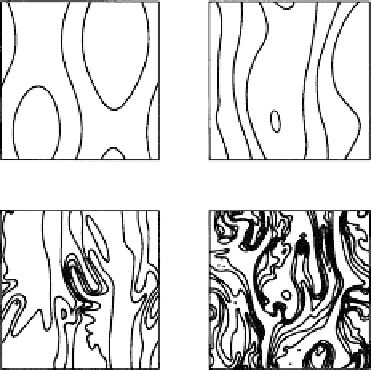Geoscience Reference
In-Depth Information
t50
t50.64 s
t
5
1.28 s
t
5
2.70 s
Figure 4.36
Plasma density contours showing the development of the equatorial irreg-
ularities at four selected times. The contour spacing is 2.5% of the ambient density, and
the grid spacing is 1
5m. [After McDonald et al. (1975). Reproduced with permission of
the American Geophysical Union.]
.
(1977), Keskinen et al. (1979), and Sudan (1983). The approach is best suited
to zero-order conditions such that
V
D
C
s
, and they therefore were able
to apply Kadomtsev's (1965) strong turbulence-weak coupling equations to
the gradient drift turbulence. These equations are, essentially, the Fourier-
transformed version of the direct interaction approximation developed by
Kraichnan (1967). One of the crucial features is that the nonlinear damping
rate due to wave emission and cascade is much larger than the linear damping
rate because these waves interact for a long time. This in turn relies on the fact
that the waves are almost dispersionless and therefore all the waves have nearly
equal group velocities. Farley (1985) has reviewed this theory, and we follow his
approach here. The object is to predict the two-dimensional spectrum of den-
sity fluctuation turbulence
I
k
(
<
k
)
such that the total density fluctuation strength
(dimensionless) is given by
I
k
(
2
(
n
/
n
)
=
k
)
d
k
⊥
For isotropic turbulence in the plane perpendicular to
B
=
B
a
y
,
ˆ
I
k
(
k
)
=
I
k
(
k
)
where
k
x
+
k
z
1
/
2
k
=
k
=
that describes the flow
of energy in the system as a function of
k
. There are two main effects: the linear
The goal is to derive a differential equation for
I
k
(
k
)

Search WWH ::

Custom Search